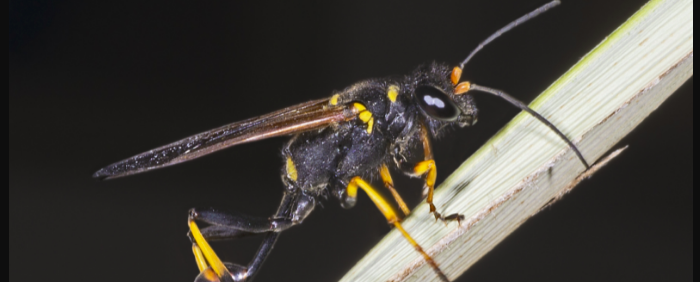
This wasp is black with yellow markings. She has a long, slender waist (pedicel) that measures about the same length as the rest of her abdomen. Its total length varies from 24 to 28 mm.
Life cycle
After mating, the female builds a mud nest. This is made up of several tubular cells the size of a date. Each of these cells is intended for a larva. When a cell is finished, the female goes on a hunt and stores enough spiders to feed the larva until its metamorphosis. A cell usually contains 6 to 15 spiders, sometimes up to 40. Live prey is paralyzed, thus constituting a reserve of fresh food. The female lays an egg on one of the spiders and then closes the cell with mud. She continues building the nest until it has about 25 cells.
The larvae develop for a few weeks then transform into pupae in their cell, where they overwinter. The adults emerge from their cells in the spring.
Geographical distribution
The Mason Pelopee is found from southern Canada to Central America and the West Indies. This species has been accidentally introduced to many countries in Europe, Australia and several islands in the Pacific.
Habitat
In the natural environment, the mason pelopee builds its nest in places sheltered from the rain. However, she can use human-made structures such as houses, attics, farms, bridges, and more.
Food
The adult feeds on nectar from the flowers of different families. This species has already been observed at hummingbird feeders.
The larvae generally feed on spiders belonging to the araneid and thomisid families.
What you need to know
The Latin name of this wasp, caementarius , means “mason, builder of walls”. The mason pelopea is able to build a nest of mud and saliva formed of several cells.
To do this, she must locate a source of building material. It is preferably clay, but mud is also suitable. The insect collects the mud using its front legs and mandibles. It incorporates saliva and forms a small soft ball that it transforms into a sliver of mud. Building a cell usually takes less than an hour and requires an average of 30 to 40 mud harvests. When the nest which is made up of several cells stuck to each other is finished, the wasp seals it by covering it entirely with an additional layer of mud.
The female emits a characteristic buzzing sound when working the mud. This sound is produced by the vibration of his flight muscles. The vibration also has the effect of liquefying the mud, which strengthens the construction.
Ecological roles
This wasp is predatory and plays an ecological role in the food chain.